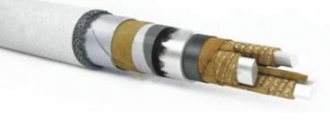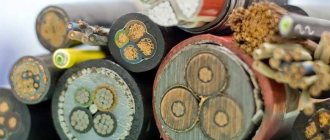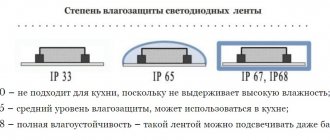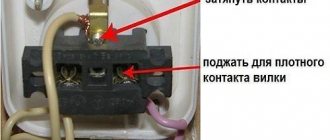How to find the length of a wire knowing the density
How to find the length of a conductor Finding the length of a conductor is very simple - just measure it.
However, if the conductor is not accessible or is very long, then measuring it directly can be very difficult. Related articles: Instructions 1 To find the length of the conductor, measure the lengths of its individual sections with a tape measure and add them up. This method is suitable for open wiring and wire measurements in temporary cable connections. 2 If the electrical wiring is hidden, then use the appropriate wiring diagram to find the exact length of the conductor. If there is no such diagram, then try to indirectly restore the placement of the wires based on the position of sockets, switches, junction boxes, etc. signs. 3 Consider the important rule of electricians: all wires must be laid strictly horizontally or vertically. Moreover, horizontal sections of wire, as a rule, run along the upper edge of the wall (under the ceiling). However, only a special device or an experienced electrician can determine the actual location of the wires. 4 If it is impossible to restore the trajectory of hidden electrical wiring, then measure the electrical resistance of individual sections of the conductor. For calculations, also specify the cross-section of the wire and the material from which it consists. As a rule, this is copper or aluminum. Since the formula for calculating resistance is: R = ρ * L * s, the length of the conductor can be calculated using the formula: L = R / ρs, where: L is the length of the conductor, R is the resistance of the conductor, ρ is the resistivity of the material from which the conductor is made ,s – cross-sectional area of the conductor. 5 When calculating the length of the conductor, take into account the following parameters and ratios. The resistivity of a copper wire is 0.0154 - 0.0174 ohms, aluminum: 0.0262 - 0.0278 ohms. (If the length of the conductor is 1 meter and the cross-section is 1 mm²) .The cross-section of the conductor is: s = π/4 * D², where: π is the number “pi”, approximately equal to 3.14, D is the diameter of the wire (which can be easily measured with a caliper). 6 If the wire is wound into a coil, then determine the length of one turn and multiply by the number of turns. If the coil has a round cross-section, then measure the diameter of the coil (the average diameter of the winding if it is multilayer). Then multiply the diameter by the number “pi” and by the number of turns: L = d * π * n, where: d is the diameter of the coil, n is the number of turns of the wire. Related articles:
Calculator for calculating cable length on a drum
Cable length on the drum: 625.44 meters
Calculation is carried out using the formula L=3.14*l*(D2н - d2ш)/(4*D2*103) , where:
L - total length of cable or wire (m)
l — length of the drum neck (mm)
Dн - diameter of the wound cable on a drum (mm), measured physically
dsh - diameter of the drum neck (mm)
D - cable diameter (mm), requested from the manufacturer or using data from the Internet, it is also possible to measure it yourself
Attention! This calculation method gives an approximate footage.
Examples
Using simple examples, we will show how to solve problems involving calculating current strength using the formula.
Task 1.
Solution: When connecting load elements in parallel, U = const, that is, the voltage is the same on all resistors and is 100 V. Then, according to Ohm’s law, I = U/R
To calculate the required parameter over the entire section of the circuit, we need to know the total resistance of this section. Considering the fact that when load elements are connected in parallel in a circuit, their total resistance is equal to:
We have: 1/R= 1/5 + 1/25 + 1/50 = 13/50; R = 50/13 ≈ 3.85 (Ohm)
Then: I = U/R = 100 V/3.85 Ohm ≈26 A.
Answer:
Task 2.
Solution:
Let's use the formula to find the current, including voltage and power: I = P/U.
Task 3.
Solution.
Applying Ohm's law for the complete circuit, we write: I = ε / (R+r′)
I = 6 V / (5 Ohm + 1 Ohm) = 1 A.
Answer: current is 1 A.
Task 4.
Solution:
During time t, electricity will do the work A = U*I*t .
The network voltage is known - it is 220 V. We find the current strength using the formula: I = U/R, then A = (U 2 /R)*t or
A = ((220 V) 2 / 40 Ohm) * 2 h = 2420 Wh = 2.42 kWh
Answer: For 2 hours of operation, an electric stove consumes 2.42 kW hours of electricity.
Using formulas for calculating the parameters of electricity, using the fundamental laws of physics, you can find unknown data for the constituent elements of circuits and electrical appliances in order to assess their condition. In each individual case, it is necessary to determine known current parameters that can be used in further calculations. Typically this is voltage, power or load resistance.
Superconductivity
Also in nature there is such an effect as superconductivity . Superconductivity is when some materials and their alloys have no resistance at all. That is, their resistance is very, very close to zero. But, I hasten to disappoint you, this is impossible to achieve under simple conditions, since this is achieved only at critical temperatures.
If you want to learn more about materials that are used in electronics and electrical engineering, download this book.
I recommend reading - Electric current power.
"Traveled" paths of computing
All existing calculation methods are based on Ohm's law, according to which current multiplied by voltage equals power. Household voltage is a constant value, equal to standard 220 V in a single-phase network. This means that only two variables remain in the legendary formula: current and power. You can and should “dance” in calculations from one of them. Using the calculated values of current and expected load in the PUE tables, we will find the required cross-sectional size.
Please note that the cable cross-section is calculated for power lines, i.e. for wires to sockets. Lighting lines are a priori laid with a cable with a traditional cross-sectional area of 1.5 mm².
If the room being equipped does not have a powerful disco spotlight or chandelier that requires a power supply of 3.3 kW or more, then it makes no sense to increase the cross-sectional area of the lighting cable core. But the rosette issue is a purely individual matter, because... Such unequal tandems as a hair dryer with a water heater or an electric kettle with a microwave can be connected to the same line.
For those who plan to load the power line with an electric hob, boiler, washing machine and similar “gluttonous” equipment, it is advisable to distribute the entire load over several outlet groups.
If it is not technically possible to divide the load into groups, experienced electricians recommend laying a cable with a copper core cross-section of 4-6 mm² without any fuss. Why with a copper current-carrying core? Because the strict PUE code prohibits laying cables with aluminum “filling” in housing and in actively used domestic premises. Electrical copper has much less resistance, it passes more current and does not heat up like aluminum. Aluminum wires are used in the construction of external overhead networks; in some places they still remain in old houses.
Note! The cross-sectional area and diameter of the cable core are two different things. The first is indicated in square mm, the second simply in mm. The main thing is not to confuse!
To search for tabular values of power and permissible current, you can use both indicators. If the table shows the size of the cross-sectional area in mm², and we only know the diameter in mm, the area must be found using the following formula:
Physical meaning of resistance
During this interaction, they slow down, but then, under the influence of an electric field, which accelerates them, they begin to move at the same speed. Electrons collide a huge number of times. This process is called conductor resistance.
Consequently, the electrical resistance of a conductor is considered a physical quantity that characterizes the ratio of voltage to current.
What is electrical resistance: a value indicating the property of a physical body to convert electrical energy into thermal energy due to the interaction of electron energy with the crystal lattice of a substance. The nature of conductivity differs:
This characteristic is designated by the letter R and measured in Ohms (Ohm) . The use of these groups of substances is very significant for the development of electrical circuit diagrams of devices.
To fully understand the dependence of R on something, you need to pay special attention to the calculation of this value.
How to calculate the current cross section?
Table values cannot take into account the individual characteristics of the device and network operation. The specificity of the tables is average. They do not list the parameters of the maximum permissible currents for a particular cable, but they differ for products of different brands. The type of gasket is touched upon very superficially in the tables. For meticulous craftsmen who reject the easy way of searching through tables, it is better to use the method of calculating the cross-sectional size of a wire based on current. More precisely, by its density.
Allowable and operating current density
Let's start with mastering the basics: remember in practice the derived interval 6 - 10. These are the values obtained by electricians over many years of “experimental methods”. The strength of the current flowing through 1 mm² of copper core varies within the specified limits. Those. a cable with a copper core with a cross-section of 1 mm² without overheating and melting of the insulation allows a current of 6 to 10 A to easily reach the waiting consumer unit. Let's figure out where it came from and what the designated interval fork means.
According to the code of electrical laws PUE, 40% is allocated to the cable for overheating that is not dangerous for its sheath, which means:
An energy flow of 12 A in a copper millimeter channel will initially be “crowded”. Due to the crowding and crowding of electrons, the current density will increase. The temperature of the copper component will then increase, which will invariably affect the condition of the insulating shell.
Please note that for a cable with aluminum current-carrying conductor, the current density displays an interval of 4 - 6 Amperes per 1 mm² of conductor.
We found out that the maximum current density for a conductor made of electrical copper is 10 A per cross-sectional area of 1 mm², and normal is 6 A. Therefore:
Minimum construction lengths
We give examples of these characteristics that exist for various groups of electrical cables.
Minimum face-to-face length of power cables
-In a polymer (PVC, plastic) insulator
| Electrical voltage, kV | Conductor cross-section, mm | Construction length, m | Max batch share/min length |
| until 3 | 1,5-16 | 150 | up to 20%/50 m |
| 25-70 | 300 | up to 10%/50 m | |
| from 95 | 200 | ||
| 6 | 10-70 | 450 | up to 20%/50 m |
| from 95 | 400 |
The face-to-face length of certain cable brands, for example, AVBbShv, may vary slightly.
| Conductor cross-section, mm | Construction length, m |
| 6-16 | 450 |
| 25-70 | 300 |
| from 95 | 200 |
-In an impregnated paper insulator
| Electrical voltage, kV | Conductor cross-section, mm | Construction length, m (in a batch without undersized sections, 70%/30%) | Small size pieces (max share per batch/min length) |
| 1/3 | <70 | 300/450 | 10%/50 m |
| 95/120 | 250/400 | 10%/50 m | |
| >150 | 200/350 | 10%/50 m | |
| 6/10 | <70 | 300/450 | 5%/100 m |
| 95/120 | 250/400 | 5%/50 m | |
| >150 | 200/350 | 5%/50 m | |
| 20/35 | All | 250/250 | 5%/100 m |
-Flexible in rubber insulator
| Brand/Version | Construction length, m | Small size pieces (min length/max share in batch) |
| , KGN, KPGU | from 125 | from 20 m/up to 20% |
| PRS | from 100 | from 10 m/up to 10% |
healthy:
We recommend that you read the article from which you will learn how to calculate the cable on a drum.
Minimum construction cost of control cables
| Brand | Construction length, m | In the party |
| in PVC insulator and sheath | ||
| KUGVV | from 100 | 80 |
| 3-100 | 20 | |
| KUGVEV | from 100 | 50 |
| 3-100 | 30 | |
| 10-30 | 20 | |
| KUGVVE | from 100 | 70 |
| 3-100 | 20 | |
| 10-30 | 10 | |
| in PVC insulator, KUPV, KUPV-P, KUPV-Pm, KUPV-Pn | ||
| Without screen | from 201 | from 70 |
| 21-200 | up to 30 | |
| Shielding, incl. partial | from 201 | from 50 |
| 1-=200 | up to 50 | |
| in polyethylene insulation for fixed installation, KPV, KPVB | ||
| Without screen | from 201 | from 40 |
| 101-200 | up to 40 | |
| 35-100 | up to 20 | |
| Shielding | from 201 | up to 20 |
| 101-200 | up to 40 | |
| 35-100 | up to 30 | |
Minimum construction length of signal blocking cables
| Construction length, m | Small size segments |
| from 300 | from 50 m |
When calculating the estimated construction length of signaling cables used for a variety of railway devices and telemechanics and automation devices, you can be guided by the data for signal interlocking products (small lengths - up to 5% of the batch).
General information
Electric current is the directed movement of charge carriers under the influence of electromagnetic force. The nature of its appearance is related to the structure of the body. At room temperature, the energy state of a substance can be described as equilibrium. Bodies consist of molecules and atoms. In turn, the latter include protons and neutrons. They form a nucleus around which negatively charged particles—electrons—orbit.
A molecule or atom has a neutral charge. This is due to the fact that the number of electrons is equal to the number of protons. If an external force is applied to the body, for example, an electromagnetic field, deformation, heating, then negative particles can receive additional energy. As a result, interatomic bonds will be broken, and electrons will leave the orbitals, becoming free. Under the influence of force, their movement will become orderly - a current will arise.
In addition, unbound electrons can exist in the structure of the body. Their origin is associated with impurities in substances and structural defects. In fact, they are also free. In an equilibrium state, their movement is random and is caused by thermal fluctuations. Depending on the number of free particles that can participate in charge transfer, all bodies are divided into two large classes:
There is also a class located between dielectrics and conductors, called semiconductors. Its main difference is the high dependence of the degree of electrical conductivity on temperature and the number of impurities. Moreover, a semiconductor has the characteristics of both a dielectric and a conductor.
From the point of view of electricity, bodies are characterized by two properties: electrical conductivity and resistance. These two parameters are inversely proportional to each other. Thus, calculating their values makes it possible to determine what type a particular substance belongs to. Conductors are characterized by a low resistance value and high electrical conductivity, while dielectrics are characterized by the opposite.
Conductors on printed circuit boards
As you know, all circuits consist of wires or printed tracks that connect various radio elements into a single whole. For example, in the article “The simplest sound amplifier,” I connected various radio elements using wires, and I got a circuit that amplified sound frequencies.
In order for everything to be beautiful, aesthetically pleasing and take up little space, “wiring” is created directly on the boards, which are already called “printed tracks”.
At home, all this is done using LUT technology (Laser-Ironing-Technology).
On the other side of the printed circuit board there are already radio elements
Since radio amateurs try to make their devices as small in size as possible, the installation density increases. Therefore, in some cases, radio elements and printed tracks are located on both sides of the board.
Industrial printed circuit boards are already made multilayer. They consist of layers, like a cake made of layers:
The boom in SMD technology has in turn created a need for multilayer printed circuit boards.
Which cable is better to buy?
Following the strict recommendations of the PUE, for the arrangement of personal property we will buy cable products with the “letter groups” NYM and VVG in the marking. They are the ones who do not cause any complaints or quibbles from electricians and firefighters. Option NYM is an analogue of domestic VVG products.
It is best if the domestic cable is accompanied by the NG index, this means that the wiring will be fire resistant. If you intend to lay the line behind a partition, between joists or above a suspended ceiling, buy products with low smoke emission. They will have the LS index.
This is a simple way to calculate the cross-section of the cable conductor. Information about the principles of calculations will help you rationally select this important element of the electrical network. The necessary and sufficient size of the current-carrying core will provide power to home appliances and will not cause a fire in the wiring.
Source
How to find the length of a conductor
Author Olga Gromysheva asked a question in the Natural Sciences What is the formula for finding the length of a conductor? and got the best answer
Answer from Kraboch [guru] and the formula is R=p*L /S. So calculate L from here
Checking for long-term permissible current and voltage loss in more detail.
Finding the length of the conductor is very simple - just measure it. However, if the conductor is not accessible or is very long, then measuring it directly can be very difficult.
- construction tape; — ammeter (tester); - caliper; - table of electrical conductivity of metals.
To find the length of the conductor, measure the lengths of its individual sections with a tape measure and add them up. This method is suitable for open wiring and wire measurements in temporary cable connections.
If the electrical wiring is hidden, then use the appropriate wiring diagram to find the exact length of the conductor. If there is no such diagram, then try to indirectly restore the placement of the wires based on the position of sockets, switches, junction boxes, etc. signs.
Please note an important rule for electricians: all wires must be laid strictly horizontally or vertically. Moreover, horizontal sections of wire, as a rule, run along the upper edge of the wall (under the ceiling). However, only a special device or an experienced electrician can determine the actual location of the wires.
When calculating the conductor length, consider the following parameters and ratios.
The resistivity of copper wire is 0.0154 - 0.0174 ohms, aluminum: 0.0262 - 0.0278 ohms. (If the length of the conductor is 1 meter and the cross-section is 1 mm?).
The cross section of the conductor is:
If the wire is wound into a coil, then determine the length of one turn and multiply by the number of turns.
If the coil has a round cross-section, then measure the diameter of the coil (the average diameter of the winding if it is multilayer). Then multiply the diameter by pi and the number of turns:
d is the diameter of the coil, n is the number of turns of wire.
Specific resistance is a characteristic of the material from which the conductor is made.
The electrical resistance of a conductor is directly proportional to the product of the resistivity of the material from which the conductor is made and its length, and inversely proportional to its cross-section.
| electrical resistance of the conductor, | Ohm |
| resistivity of the conductor material, | Ohm m |
| conductor length, | Meter |
| conductor cross section, | Meter2 |
SI unit of resistivity
Specific resistance ρ depends on temperature.
Calculation and selection of wire cross-section in various ways
It is known that all metals have free electrons that move in the presence of an applied electrical voltage, creating an electric current. When they hit atoms, they lose energy, which turns into heat. The greater the current, the denser the flow of particles, and the smaller the cross section of the conductor through which they pass, the more crowded they are; collisions are more frequent, useful energy is lost, and the release of useless and often dangerous heat increases.
Avalanche of heat
Important! As the temperature rises, the resistivity increases and heat release increases, which leads to an avalanche-like process of rapid heating with catastrophic consequences.
But, in everyday life, ready-made tables are used, which take into account the possibility of cable overheating in hidden wiring - in this case, for the same current and power values, the cross-section is prescribed to be large for the cable in poorly ventilated and thermally insulated places, so that the heating does not exceed the permissible limit.
Solution in practice
It is carried out using special tables and PUE standards, according to which the cable cross-section is selected. The cross-sectional value of the conductor is selected in several ways:
Selection by power
Each electrical appliance indicates its rated power. By summing up the power of electrical appliances that are planned to be connected to the designed electrical network at the same time, get a certain number and, using the table, select the appropriate cross-section of a copper or aluminum cable, choosing the appropriate power value.
First of all, it is necessary to take into account the expected load on the electrical wiring that we are going to lay. If there are several electrical appliances on one section of the electrical network, then to calculate the expected load we add up all their capacities. After calculating this indicator, we analyze the method in which we will lay the electrical networks (open or closed), as well as the impact of what temperature conditions will be exerted on the wires.
It is also very important to calculate the correct cable cross-section because errors in calculations will lead to power losses in the wires. If this is not so significant for household appliances, then on an industrial scale this can lead to quite serious waste.
where P1 is the power of, for example, a kettle of 1.5 kW, P2 is the power of a vacuum cleaner of 1.6 kW, etc.
After calculating the total power, select the wire cross-section (copper or aluminum) in table 1:
Table 1 - Selection of wire cross-section by power
Current selection
In Table 2 you can find the correspondence between cross sections and rated current. Selection based on this parameter is considered more accurate. It is necessary to look at the passports and labels of electrical appliances; the rated power is usually indicated, and then follow the same procedures as in the method described above.
where Ptot. — total power of electrical appliances (W).
To do this, the tester is connected to an open circuit - in practice, you can take a piece of network cable with a plug, connect one core to the socket terminal, and feed the other to the measuring device. Connect the other ammeter probe to a free terminal of the socket, and turn on existing household appliances one by one, in different operating modes, checking the parameters declared by the manufacturers.
After we have summed up the currents of electrical appliances, we select the conductor cross-section from the table:
Table 2 Relationship between current and conductor cross-section
The wire is already there
In the opposite situation, when there is a cable, but the markings are not visible, you need to find out its rated current and power; to do this, measure the diameter of the wire with a caliper or micrometer. You can get by with a ruler, if the core is flexible enough, wind it around a thin rod, measure the length of the resulting spiral, divide by the number of turns - the result will correspond to the diameter.
Using the formula, we calculate the cross-sectional area of the conductor:
It is better to choose the cable cross-section with a margin. It is prohibited to operate a cable wound into a coil due to its inductive reactance.
Installation of aluminum cables should be carried out with extreme caution - frequent bending and straightening produces invisible cracks that reduce the cross-section, resistance increases in this place and spot overheating occurs.
Length check
where l is the length of the wire (m), ϱ is the resistivity of the conductor (Ohm*mm²/m) (see Table 2), S is the cross-sectional area of the conductor, determined from the method described above (mm²)
Table 3 - resistivity of metals:
where I is the total current in your network (A), R is the calculated resistance (Ohm).
If the obtained value exceeds 5% of the network voltage, the cable cross-section must be increased according to table 1.
Measuring instruments
The instruments used are a micrometer and a caliper. Mechanical devices are usually used, although there are also electronic ones with a digital display. One of these devices will always be found among the home owner's tools.
The most commonly used caliper is suitable for measuring wires in an active network, for example, in a panel or socket. The cross-sectional area of the conductor is found as follows:
where D is the diameter of the wire.
Measuring wire diameter with a caliper
In the absence of instruments, the diameter of the wire is determined using a ruler. To do this, the insulation is cleaned from the core and wound tightly around a pencil (at least 15 turns). Then measure the length of the winding and divide it by the number of turns. The coils must be laid evenly and adjacent to each other without gaps.
Measuring wire diameter using a ruler
Take several measurements from different sides. Then the result will be more accurate. Wires of great thickness cannot be wound onto a pencil, and a check in a store can only be done after purchasing the product. The cross-sectional area can be determined using a formula or using a table.
S total – total cross section,
Calculation of the maximum cable winding length
The maximum length of cable winding is most often taken from ready-made tables of norms for winding cables on a drum. However, if they are not at hand, then the formula for maximum cable winding on a drum, which is similar to the one provided above, will come to the rescue. The formula looks like this:
L=3.14*l*((Dsch-100)2 - d2sh)* kу/(4*D2*103) , where:
L - total length of cable or wire (m)
l — length of the drum neck (mm)
Dsch — jaw diameter (mm)
dsh - diameter of the drum neck (mm)
D - cable diameter (mm)
kу is the cable shrinkage coefficient. Typically accepted between 0.8 and 0.95
According to GOST 18690-82 “Cables, wires, cords and cable fittings. Labeling, packaging, transportation and storage" the minimum distance between the upper turns of the product and the edge of the cheek should be:
- not less than 50 mm - for cables and wires (except for winding wires);
- 25 mm - for winding wires;
- 5 mm - for products with a conductor diameter of more than 0.05 mm;
- 3 mm - for products with a conductor diameter of up to 0.05
when winding on reels:
Therefore, in the formula for maximum cable winding on a drum, 100 mm is subtracted from the jaw diameter (Dsch) (50 mm on each side of the jaw).
How to calculate a cable by power and length
Calculation of industrial electrical networks is carried out on the basis of several technical indicators. But when it comes to household lines, one parameter is usually taken as a basis - the power of household appliances and lighting.
Therefore, calculating cable power is the only correct method to correctly assemble the electrical wiring of a house. Of course, you will also have to take into account the length of each cable, because modern private houses are sometimes entire palaces where kilometers of cable are laid.
But the calculation is still based on power.
Let's start with the fact that the power characteristics of household appliances can be found on the devices themselves or in the accompanying documentation (passport, instructions, etc.). Please note that some devices indicate two values: average power value and maximum. For the calculation, it is the second one that is needed.
It should be noted that some household appliances operate in different modes. For example, a washing machine can consume only a few tens of watts in the rinse mode, or hundreds of watts in the washing mode, and several kilowatts in the water heating and boiling mode.
That is, at a certain moment the machine consumes different power.
No one can determine at what exact moment washing with boiling will be carried out, therefore, in order to make the correct selection of the cable, it is necessary to take as a basis the maximum power indicator.
By the way, you will also have to calculate the electrical wiring for the air conditioner in the same way. After all, this device will consume only 50-60 watts in simple ventilation mode, and 1.0-1.0 kW in air conditioning mode.
Parameters for performing calculations
Remember one point - the electrical network of the house is divided into sections (loops), in which it is necessary to carry out calculations separately. Plus calculate the cross-section of the common wire leading to the house.
The thing is that the number of household appliances and light sources in different rooms will differ. For example, there will be more of them in the kitchen; in the hallway there is nothing at all except lighting.
In addition, the modern approach to electrical wiring requires dividing areas in rooms into two groups: lighting and sockets. That is, each group will have its own separate wire.
Let's look at how to correctly calculate the cable cross-section for power in one room where several household appliances are used. So, input data.
Section calculation
So, first of all, it is necessary to sum up the power of all household appliances. It's very simple, you can even do it in your head. For example, the result will be 7.5 kW. By the way, this is the average load in most city apartments. Just twenty years ago this figure did not exceed 5 kW. It's all about the increase in the number of household appliances we use.
Now we move on to implementing the choice of electrical wire material. Comparing the table, we can conclude that in the case of a copper cable the cross-sectional value will be equal to 4 mm², and with aluminum – 6 mm². At the same time, copper with a cross-section of 4 mm² can withstand a load of up to 8.3 kW, aluminum up to 7.9 kW.
That is, a certain safety margin has already been built in, which increases the reliability of the electrical wiring.
Attention! Regardless of the fact that the power reserve has already been determined, it is recommended to take a slightly larger cable cross-section (up to the next indicator). This is done for the future, because there is a high probability that new household appliances will appear in the house, which will increase the total load on the network.
Now, regarding the three-phase network. In many private houses, three phases are supplied, and in some city apartments they are also present. Basically, what is a three-phase network? These are three phases and zero. That is, it turns out that three single-phase networks enter the house.
All calculations related to power and wire cross-section are carried out in exactly the same way as with a single-phase network. True, there is one strict requirement - the total load must be distributed evenly among the phases. The same example, where the power consumption of the house is 7.5 kW.
So this indicator in each phase should be 2.5 kW.
What does this mean? Remember our example, where the cable cross-section for a single-phase network was calculated at a load of 7.5 kW. It was determined that the best option for this is copper wire with a cross-section of 4 mm². Since the total load of the network is divided into three phases, each of them requires a wire with a cross-section corresponding to a power of 2.5 kW. And this is 1.5 mm².
Dependence of the area of an electrical wire on its length
Typically, the wire cross-section is calculated based on power and length. That is, the longer the wiring, the greater the power loss due to the fact that the metal wire has resistance. And it increases as the cable length increases.
Since in private houses the electrical wiring loops are not so long, this calculation can be neglected. In industry, everything is different; the dependence of cable length and cross-section through power losses is obvious. Therefore, for information, let’s consider this calculation for a single-phase network.
Parameters for performing calculations
Remember one point - the electrical network of the house is divided into sections (loops), in which it is necessary to carry out calculations separately. Plus calculate the cross-section of the common wire leading to the house. The thing is that the number of household appliances and light sources in different rooms will differ. For example, there will be more of them in the kitchen; in the hallway there is nothing at all except lighting. In addition, the modern approach to electrical wiring requires dividing areas in rooms into two groups: lighting and sockets. That is, each group will have its own separate wire.
Let's look at how to correctly calculate the cable cross-section for power in one room where several household appliances are used. So, input data.
- Maximum total load of all consumers. As mentioned above, these indicators can be found in the product passport or on the tags of the device itself. If neither one nor the other is left, then the only way for you is the Internet. Today there are many sites on the Internet that offer tables with the power parameters of each household appliance. So this is not a problem today.
- Mains voltage. This is either 220 volts or 380 volts.
- The material from which the electrical wire is made. In principle, the variety here is small, only two positions: copper or aluminum. We will not go into details; there is also a table of the ratio of cable cross-section and material on the Internet. The only thing we note is that with the same power consumption, you can install a copper cable with a smaller cross-section compared to aluminum.










